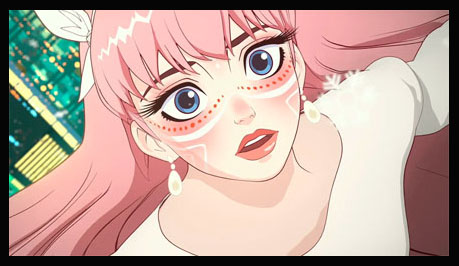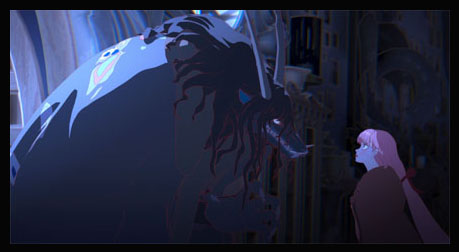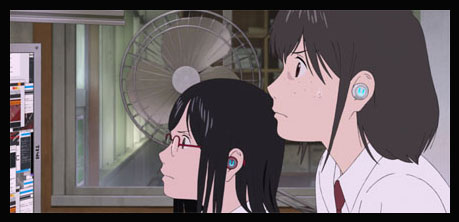
Oscar nominated Mirai director Mamoru Hosoda’s new animated feature is nominated for five Annie Awards. Belle is a modern-day update on one of the most beloved stories of all-time, Beauty and the Beast. This time, it’s a girl named Suzu who discovers the digital universe of U. She creates an avatar named Belle who instantly becomes a phenomenon. Suzu’s responsibilities soon increase. How will she use them, and how will she balance real-life with a digital one? Belle opens in theaters nationwide tonight. Hosoda discusses his screenplay and visual inspirations in this Animation Scoop Q&A. (This interview was conducted over Zoom with Hosoda and a translator.)
Jackson Murphy: It is so great to talk with you again. We spoke for Mirai a few years ago, and you have made another fantastic film in Belle. Congratulations.
Mamoru Hosoda: Yeah, it’s certainly been a while. (laughs) So tell me about your background. It looks like you’re in a movie theater.

JM: Yes, it has been my Zoom background for the past year and a half!
MH: (laughs)
JM: I’m glad you like it! Mirai was about childhood, and Belle is about teenagers and social media. Your details… the intricacy… is incredible. What fascinated you about researching teens and social media?
MH: I’ve been making movies that deal with this theme and concept of the internet for, I wanna say, 20 years now — going all the way back to Digimon and then more recently Summer Wars and, of course, Belle. Over the course of this time, there’s been a massive shift in the social media space. And the reason why I wanted to feature teens in this backdrop is because I think they’re almost always at the center of this change, and they’re very sensitive to what is happening and very aware of this shift in many ways.

Partially I believe that is because they understand… that they are going to have to co-exist with whatever it is that is newly being developed in the social media space and utilize it in many ways. I suppose it’s this vitality teenagers have to be able to face these different changes and adopt it and integrate it into their lives that made me want to tell this story of Belle, which adopts social media and tells that narrative with the coming-of-age backdrop.
JM: I completely agree with that. It’s an excellent, deep story. My all-time favorite movie is the animated version of Beauty and the Beast. What kinds of pressure did you feel in trying to honor that story and that movie with the many sequences in Belle?
MH: With regards to Beauty and the Beast, what I wanted to do with Belle is provide an interpretation with a much more present day backdrop. Of course, Disney’s Beauty and the Beast — I myself was really, really moved by this. And I’m sure that you can relate. I had seen it very early in my animation career, and it was one of the movies that helped me get going in the industry. So I told myself I wanted to make my own interpretation — my own version of Beauty and the Beast someday. And of course it took me 30 years to do that. But here we are!
So you look at the story of Beauty and the Beast and it dates all the way back to 17th Century France, the original work, and then in 1946 Jean Cocteau directed a movie, and then more recently in ’91 Disney’s Beauty. Over the years, what they express and what they comment on, socially, I think has changed. When Disney’s Beauty and the Beast was released in ’91, I think at the time it felt very, very fresh. It felt like Beauty and the Beast updated for the modern era. But when you put it into perspective, it’s actually been 30 years since Disney’s Beauty. I like to think about, over the course of these different interpretations and over the course of the eras, what has changed and what has remained the same in terms of values.

For me, one of the biggest changes was the character, Belle. In the 17th Century original work of classical literature, she was really one-dimensional in that she was the beauty and it was entirely about the exterior. It was entirely about how she looked. But today I think beauty isn’t simply about exterior, visual beauty. The strength that these characters have is very beautiful in many ways, and there’s been a massive shift in values, which I wanted to represent in an updated version.
JM: You do a fantastic job. What was the biggest challenge of creating the digital world of U (which is just incredible to look at)?
MH: That was certainly a big challenge. When thinking about the world of U, it is very much another reality that exists inside of the internet. And how do we take this concept and translate it into something that can be interpreted or transmitted visually? We used that very internet. I came across an architect, Eric Wang, based in the UK. He had no movie experience whatsoever, but I really admired what he had done in his portfolio. So we then got talking about, “Well, how do we translate this very abstract concept of the internet and our relationship with it into something that can be visualized and interpreted that way?” So… through those conversations we were able to arrive at what you see in the movie.
JM: Congratulations on the film, and all the best this awards season with the Annie Awards and with the Academy Awards. I hope you’re nominated again! Thank you so much for your time today.
MH: Thank you very much for interviewing me and playing a part in that. And hopefully… fingers crossed for everything with the Annies and the Oscars.
- INTERVIEW: “Inside Out 2” Director And Producer On Pixar Sequel - April 16, 2024
- INTERVIEW: “Puffin Rock And The New Friends” And 25 Years Of Cartoon Saloon - April 10, 2024
- INTERVIEW: “Chicken For Linda!” Directors On Annecy Winning Feature - April 9, 2024


 January 13th, 2022
January 13th, 2022  Jackson Murphy
Jackson Murphy  Posted in
Posted in  Tags:
Tags: 






